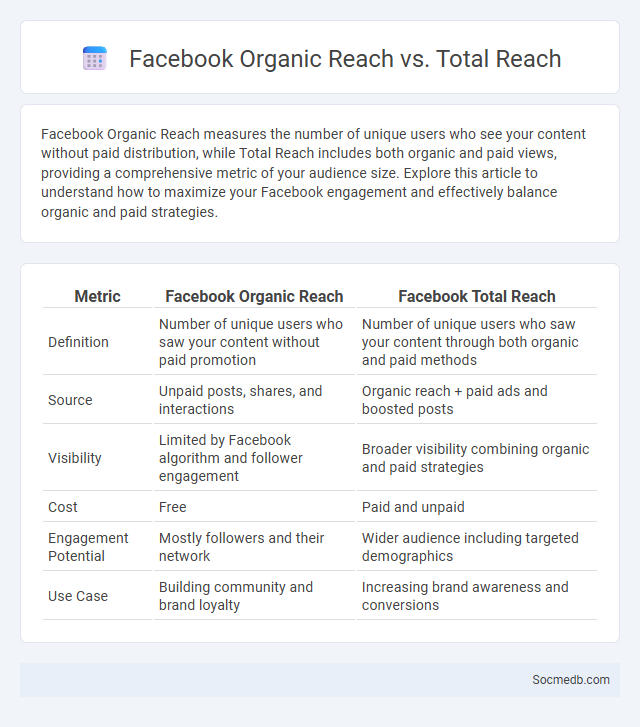
Photo illustration: Facebook Organic Reach vs Total Reach
Facebook Organic Reach measures the number of unique users who see your content without paid distribution, while Total Reach includes both organic and paid views, providing a comprehensive metric of your audience size. Explore this article to understand how to maximize your Facebook engagement and effectively balance organic and paid strategies.
Table of Comparison
| Metric | Facebook Organic Reach | Facebook Total Reach |
|---|---|---|
| Definition | Number of unique users who saw your content without paid promotion | Number of unique users who saw your content through both organic and paid methods |
| Source | Unpaid posts, shares, and interactions | Organic reach + paid ads and boosted posts |
| Visibility | Limited by Facebook algorithm and follower engagement | Broader visibility combining organic and paid strategies |
| Cost | Free | Paid and unpaid |
| Engagement Potential | Mostly followers and their network | Wider audience including targeted demographics |
| Use Case | Building community and brand loyalty | Increasing brand awareness and conversions |
Understanding Facebook Organic Reach
Facebook organic reach measures the number of unique users who see a brand's content without paid promotion, influenced by factors such as post engagement, content relevance, and algorithm changes. Posts that encourage interactions like comments and shares typically achieve higher organic reach, boosting visibility within a user's network. Maintaining consistent posting schedules and using diverse media types, including videos and images, enhances organic reach by aligning with Facebook's content prioritization protocols.
Defining Facebook Total Reach
Facebook Total Reach represents the unique number of users who have seen any content from your page or about your page within a specific time frame. This metric includes views from posts, ads, and shared content, capturing the broader audience engagement beyond just followers. Monitoring Your Facebook Total Reach helps optimize content strategy and measure the effectiveness of social media campaigns.
Differences Between Organic Reach and Total Reach
Organic reach on social media refers to the number of unique users who see content without paid promotion, driven primarily by followers and shares. Total reach combines both organic reach and paid reach, encompassing all unique users exposed to the content through advertising and paid campaigns. Understanding the distinction is crucial for optimizing marketing strategies and accurately measuring audience engagement.
How Facebook Calculates Organic Reach
Facebook calculates organic reach by counting the unique users who see a post without paid promotion. The algorithm prioritizes content based on user engagement, relevance, and interaction history, favoring posts from friends, family, and groups a user frequently interacts with. Factors such as post type, timeliness, and content quality also influence the distribution and visibility to maximize authentic user engagement.
Factors Influencing Organic Reach
Organic reach on social media is influenced by factors including content relevance, audience engagement, and platform algorithms prioritizing meaningful interactions. Your post's timing and use of visuals can significantly impact visibility, as social media platforms favor content that sparks genuine conversations. Understanding these elements helps you optimize posts for increased organic reach and stronger community connection.
Components of Total Reach on Facebook
Total Reach on Facebook consists of Organic Reach, Paid Reach, and Viral Reach, each representing different audience interactions. Organic Reach measures users who see posts naturally without paid promotion, while Paid Reach tracks users reached through advertisements. Viral Reach accounts for users exposed via shares, comments, or other interactions driven by audience engagement, collectively optimizing visibility and advertising impact on Facebook.
Impact of Paid Promotions on Total Reach
Paid promotions on social media significantly amplify total reach by targeting specific demographics, increasing visibility beyond organic followers. Platforms like Facebook and Instagram utilize advanced algorithms to optimize ad delivery, resulting in higher engagement rates and expanded audience exposure. The strategic investment in paid campaigns directly correlates with improved brand awareness and accelerated growth in follower counts.
Strategies to Boost Organic Reach
To boost your organic reach on social media, create high-quality, engaging content tailored to your target audience's interests and behaviors. Utilize platform-specific features like Instagram Stories, Twitter Threads, or LinkedIn Articles to maximize visibility and encourage interaction. Consistent posting schedules combined with genuine community engagement, such as responding to comments and joining relevant conversations, significantly enhance your content's discoverability and shareability.
Measuring and Analyzing Reach Metrics
Measuring and analyzing reach metrics on social media involves tracking the total number of unique users who see your content, providing insight into your brand's visibility and audience engagement. Key metrics include impressions, reach per post, follower growth, and demographic data, helping you identify which content resonates most with Your target audience. Utilizing analytics tools like Facebook Insights, Instagram Analytics, or third-party platforms allows for data-driven decisions to optimize future social media strategies.
Best Practices for Maximizing Both Organic and Total Reach
To maximize both organic and total reach on social media, focus on creating high-quality, engaging content that resonates with your target audience while leveraging platform-specific features like hashtags, stories, and reels. Consistently analyze your engagement metrics and adjust your posting schedule to align with peak activity times for your followers. You should also encourage user interaction through polls, comments, and shares to boost algorithmic visibility and drive sustained organic growth.
 socmedb.com
socmedb.com